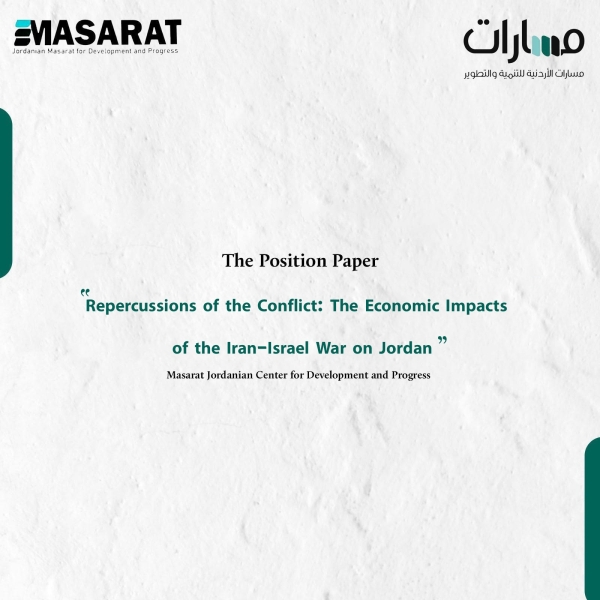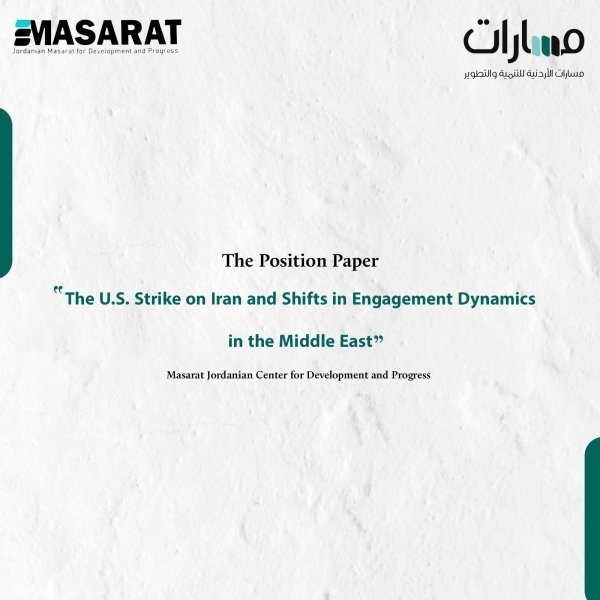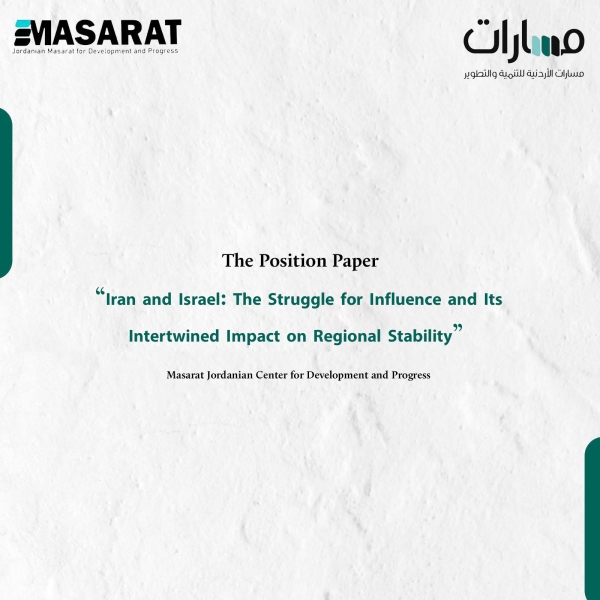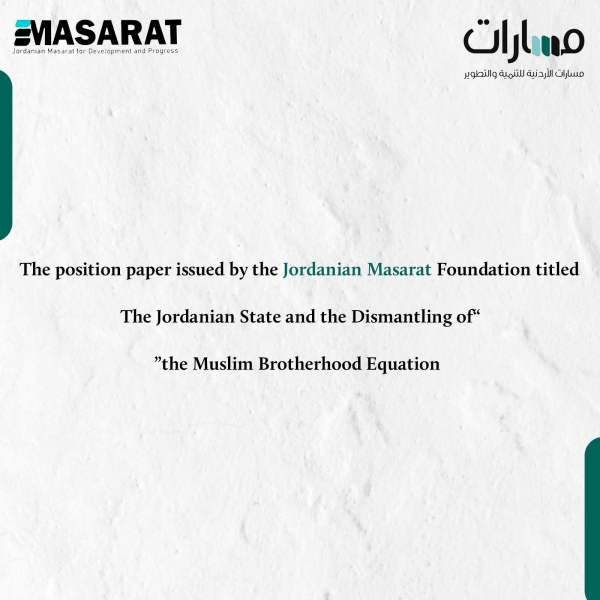Hedging and Construction Equations in Jordan... An Objective Reading of the Renewed Challenges of the Middle East
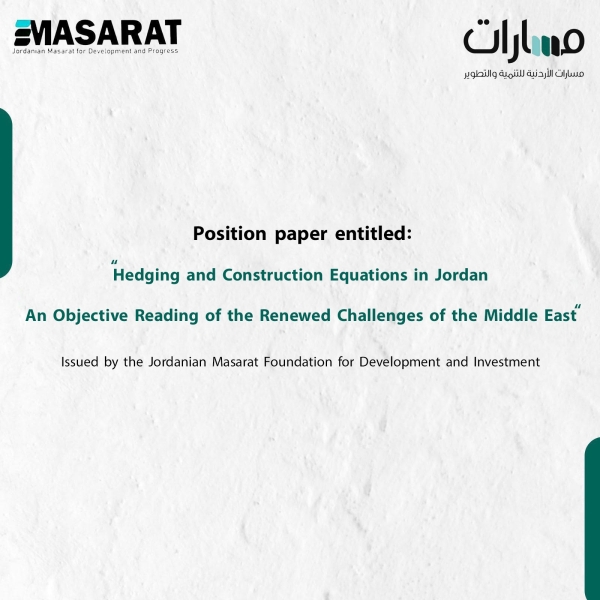
Introduction:
The Jordanian landscape is shaped by the interplay of complex domestic factors and highly influential regional and international dynamics, making the modernization of political, economic, and social institutions both inevitable and essential—and inseparable from the surrounding challenges. With the continuation of Israeli occupation policies aimed at fragmenting Palestinian land and displacing its people, alongside ongoing escalation in the West Bank and Gaza Strip, Jordan finds itself at the heart of a delicate equation that requires carefully balancing the protection of Palestinian rights, safeguarding national security, and addressing the repercussions of regional conflicts—particularly the Syrian crisis, which has added new layers of complexity to the region’s political and social scene.
In addition, Jordan must contend with the legal dimensions related to recognition of the State of Palestine and its international obligations regarding the right of return and resistance, amid persistent attempts to alter facts on the ground. All these challenges intersect with the urgent need to launch a comprehensive national project of political and economic modernization—one that builds strong, independent institutions; advances sustainable, self-reliant economic development; supports a free media capable of raising public awareness; and establishes a modern education system that fosters critical thinking and prepares future generations for the demands of the twenty-first century.
The ability to overcome these hardships and setbacks lies in adopting a coherent national vision that combines resilience in the face of external risks with deep internal reform.
Chapter One: The General Landscape and Context of Challenges
Jordan stands at a pivotal moment that compels a comprehensive reassessment of its position and role on the map of the “New Middle East.” This moment is the cumulative outcome of a set of intertwined trajectories whose roots extend across decades of complex shifts in the regional order, interlacing with deeper international dynamics that are reshaping balances of power and patterns of alliances.
Within this frame, there is a pressing need to read the overall scene not as a series of isolated incidents, but as an integrated system of interdependent variables—where any political, security, or economic file becomes part of a broader equation that exceeds its immediate boundaries.
Recent regional developments have produced three principal focal points of concern. In their simultaneity and mutually reinforcing impacts, they constitute a compound threat to Jordan’s national security—geographical, political, demographic, and strategic:
- The Israeli annexation track in parts of the West Bank and the Jordan Valley, reflecting a qualitative shift from conflict management to the imposition of final facts on the ground. This undermines the prospects of any just political settlement, redistributes the relative weights of actors in the Palestinian file in ways that weaken Jordan’s ability to uphold its historical role linked to Jerusalem and the holy sites, and creates direct challenges within the state’s western strategic depth.
- The drive toward full control of the Gaza Strip, which implies a reconfiguration of the security landscape along the eastern and western borders of the occupied Palestinian territory. The deterrence equation and existing balances would shift, and scenarios could expand beyond Gaza to questions of displacement, population redistribution, and the creation of a new reality that may impose unprecedented security and political equations on Jordan.
- The project to establish a continuous border wall along the line of contact with the occupied Palestinian territories. Ostensibly a security barrier, it carries deeper, long-term implications for reshaping geopolitics, closing channels of human and economic interaction between the two banks of the river, and turning the border into a hardened reality that redefines Jordan’s sovereignty and vital strategic space.
Though distinct in nature, these three files are tied by a single strategic thread: the remolding of the regional environment in ways that narrow Jordan’s room for maneuver—pressing it either to accept externally imposed arrangements or to craft self-driven alternatives based on a mix of diplomatic efficiency, security resilience, and economic flexibility.
Because these challenges do not arise in a vacuum, understanding them requires a composite approach that goes beyond surface description to the deeper structure of regional relations: from the declining centrality of the Arab–Israeli conflict for some regional powers, to shifting alliance patterns among regional and international actors, and the uneven redistribution of soft and hard power.
In this light, the landscape raises central questions—not only about the capacity of Jordanian foreign policy to manage these files with a level of professionalism commensurate with their complexity, but also about the effectiveness of the national media ecosystem in producing a cohesive public consciousness capable of grasping the scale of risks without sliding into alarmism or reductive simplification. It likewise poses a dual challenge for the Jordanian decision-maker: balancing the defense of the state’s supreme interests with preserving a web of regional and international relationships that enables strategic maneuvering in a highly volatile environment.
What further complicates this moment is its intersection with domestic crises—economic pressures such as rising debt and slow growth; social strains manifesting in eroding trust between decision-making circles and society; and a geopolitical dimension that, by virtue of Jordan’s location, makes it a meeting ground for the interests of divergent regional and international powers.
Amid such entanglement, the absence of a clear strategic vision becomes a risk that could erode Jordan’s ability to influence the course of events.
Accordingly, any approach to the current landscape must begin with the recognition that Jordan is not a marginal actor in the region. It is a key player that both affects and is affected. An objective reading of the threats is incomplete unless situated within the broader framework of regional and international variables that are redrawing maps of influence and opening the door to redefining the very concepts of security, sovereignty, and strategic depth—not for Jordan alone, but for the region as a whole.
Chapter Two: Recognition of the State of Palestine — Legal and Political Dimensions and Enabling Requirements
The recognition of the State of Palestine by certain international actors represents an important symbolic and political shift in global discourse on the Palestinian question. However, the strategic value of such recognition remains contingent on the practical legal, political, and economic measures that follow. In international law, recognition is a politico-legal declaration of will which—if effectively leveraged—can open new avenues for accountability and diplomatic pressure. Limiting it to an end in itself, however, risks turning it into a merely formal step used to absolve the international community of responsibility, without meaningfully advancing statehood on the ground.
From this perspective, questions arise regarding the legal steps that flow from recognition and the possibility of linking it to decisions issued by international judicial bodies such as the International Court of Justice and the International Criminal Court. In theory, recognition can be activated as a pathway to strengthen the legitimacy of Palestinian claims before these bodies and to demand concrete commitments from recognizing states—such as restricting dealings with products originating from settlements in the occupied territories, or supporting legal efforts to criminalize occupation practices that violate the rules of international humanitarian law.
That said, any comprehensive approach to this track must also account for the internal requirements of the Palestinian side itself. International will cannot be relied upon in the absence of a legitimate representative structure that reflects the popular will and possesses the credibility and capacity to govern the envisioned state.
In this context, holding free and fair elections and establishing effective institutions capable of performing their functions even under ongoing occupation become central to maximizing the impact of any international recognition and transforming it from a symbolic step into a foundational building block of statehood.
Historical experience affirms that separating recognition from the realization of statehood is a strategic mistake: the former does not guarantee the latter unless paired with cumulative measures on the ground that redraw the balance of power in favor of establishing the state. At times, under public pressure, the international community may issue statements or decisions of recognition without attaching practical obligations such as economic sanctions, legal prosecutions, or politically consequential pressure on the occupying power.
Accordingly, any Jordanian or Palestinian strategy for dealing with a potential wave of recognitions should rest on the principle of “recognition coupled with empowerment”—that is, tying the political position to time-bound, goal-specific executive measures, whether through international institutions, bilateral agreements with recognizing states, or economic and political boycott tools that exert pressure on the settlement and occupation structure.
Linking international legitimacy on the one hand with Palestinian self-capacity on the other establishes more realistic foundations for achieving statehood and guards against settling for mere rhetorical symbolism. It also prevents a recurrence of past patterns of “recognitions emptied of substance,” employed to absorb moral and political pressure on the international community without producing real change in the balance of the conflic
Chapter Three: Jordan — Its Size, Resources, and Influence
Jordan’s decades-long reliance on external support—whether from the Gulf states or the United States—has revealed the limits of this approach amid ongoing transformations. Gulf aid has declined in quantity and quality and has become tied to specific projects rather than budgetary support, while U.S. assistance has diminished alongside political shifts that run counter to Jordanian interests—particularly with respect to the Palestinian issue, where proposed solutions push burdens directly onto Jordan at the expense of its sovereignty and vital interests. Added to this are recent economic developments such as the removal of previous customs preferences under the Free Trade Agreement with the United States and the raising of tariffs to levels that constrain the competitiveness of Jordanian exports in the U.S. market—portending an inevitable decline in export volumes unless urgent alternatives and corrective measures are developed.
At the heart of this complex environment, Israel’s policy toward the occupied Palestinian territories—including support for settlement activity and forced displacement—constitutes the most immediate threat to Jordanian national security. The absence of any horizon for a Palestinian state, coupled with the occupation’s efforts to reduce Palestinian presence in the West Bank and Gaza through systematic killing and displacement, places Jordan before a dual strategic dilemma: on the one hand, addressing potential security and demographic repercussions along its borders; on the other, confronting a clear Arab vacuum in supporting the Jordanian position within a unified and effective framework.
The claim that Jordan’s small size or limited resources precludes independent action overlooks the possibility of crafting an active, flexible foreign policy built on strengthening endogenous sources of power—economically, by diversifying partners and markets; and politically, by forging objective alliances with regional and international actors who share core interests. Just as Palestinian actors are called upon to develop their internal structures to amplify the impact of any international recognition, Jordan is likewise called to rebuild its political and economic instruments in ways that enable maneuver and initiative—rather than confining itself to reaction or reliance on a diminishing stream of external support.
Chapter Four: The Syrian Variable and Its Repercussions on Jordan in a Turbulent Regional Environment
The shifts underway in Syria are a core element of the regional security equation, with direct and indirect effects on the balances surrounding Jordan. Change in the structure of power there—though, from one angle, a necessary condition for launching a sustainable path to stability—remains, from another angle, insufficient unless paired with a real transformation in the philosophy of governance and the mechanisms of state management. There is a crucial difference between the necessary condition that opens the door to change and the sufficient condition that ensures that change materializes effectively.
Developments in the power structure in Damascus, while in one analytic register a prerequisite for a long-term stability track, do not rise—at a more complex level—to the level of sufficiency unless accompanied by a fundamental shift in the governing paradigm and a deep restructuring of state management mechanisms that breaks with the exclusionary governance patterns that helped fuel the enduring crisis.
The essential difference between the “necessary” and the “sufficient” is that the former opens the door to change in theory, while the latter—through institutional and legislative tools—converts that possibility into a stable, effective reality. Thus, the absence of a genuinely pluralistic political system in Syria—capable of accommodating the full social, sectarian, and national spectrum in decision-making—renders any prospective transition vulnerable to reproducing old patterns of exclusion under a new guise, reducing proclaimed diversity to a decorative façade lacking substantive political content.
If such diversity remains trapped within a formal frame—without translation into firm constitutional rules and broad mechanisms for public participation—the chances of transitioning to political stability anchored in a solid social base will remain slim. This, in turn, paves the way for entrenching political and social faits accomplis that, over time, can harden into barriers against any democratic or participatory path. Such a scenario reshapes the threat environment around Jordan by cementing a state of strategic uncertainty along its northern border.
For Jordan, the repercussions of the Syrian variable extend far beyond traditional security concerns such as border control or managing refugee flows; they cut to the core of the state’s strategic calculus. The continued fragility of the Syrian state creates space for regional and international actors to fill the emerging geopolitical vacuum, potentially redrawing maps of influence and alignment in ways that require Jordan to continually recalibrate its diplomatic and security tools.
Amid this risk-laden climate, Jordan must adopt an integrated approach built on three complementary dimensions:
- Proactive security hedging to prevent threats from seeping across the border;
- Active diplomatic engagement in regional and international political tracks related to the Syrian crisis; and
- Strengthening the home front—politically, economically, and socially—to safeguard national stability against potential spillovers that could exceed any single state’s capacity to contain.
Chapter Five: State-Building and the Crisis of Political and Educational Modernization under Contemporary Challenges
Are we capable of building national institutions grounded in an integrated strategic vision? The answer is unequivocally yes. We already have tracks for political and economic modernization, even if they face challenges tied to the will to implement and the depth of reform.
There is, however, a vigorous debate about the reality of political modernization. While some claim the process has stalled or been shelved, facts on the ground point to concrete plans and timelines—2021, 2023, 2024, and even 2025—that reflect a genuine national vision despite changing governments and shifting political conditions. Yet despite its merits, the process still proceeds as discrete, non-integrated pieces, which weakens its effectiveness and underscores the urgent need for more advanced mechanisms to manage it coherently and ensure its sustainability and success.
At the same time, each country has its own distinctive characteristics and constraints. We should acknowledge fundamental differences between our case and major regional states such as Saudi Arabia and the United Arab Emirates. Despite social and cultural constraints in Saudi Arabia over long periods, it has recently taken bold, accelerated economic steps rooted in the realization that reliance on oil as a sole revenue source is unsustainable over the medium and long term—especially amid global shifts suggesting the oil era may end within two to three decades. The UAE embraces a similar vision, pursuing economic diversification toward a sustainable, knowledge-based economy.
In contrast to these regional experiences, we continue to rely on a traditional, externally dependent approach whose time has effectively passed. Persisting with it merely postpones facing the complex economic and social realities we live.
Building a sovereign state capable of meeting the challenges of the twenty-first century requires bold, decisive steps across political, economic, and social fronts—moving beyond slogans or delays and translating vision into practical, sustainable policies and practices.
Among the strategic measures that must top the national reform agenda is a root-and-branch restructuring of the education system. The current system has become a real obstacle to national advancement. Education cannot be treated as mere knowledge transmission; it must be a vehicle for cultivating citizens able to engage in dialogue, accept the other, think critically, and express opinions freely and responsibly.
With global economic shifts, we can no longer depend on traditional educational outputs aimed at a labor market that no longer absorbs unqualified skills—especially as job opportunities in the Gulf, once the traditional outlet for national labor, have declined. Today, the state employs about 42% of the workforce, while the private sector suffers from a shortage of qualified labor because the education system fails to provide essential skills.
Educational transformation has thus become a pressing national necessity if we seek to develop a self-reliant economy and turn investment at home into real investment that drives growth and development. Attracting foreign investment, for example, will not be possible without a qualified, trained workforce aligned with the demands of the contemporary economy.
Accordingly, continued neglect or delay in modernizing the education system and strengthening institutional capacity will exacerbate national problems, threaten our economic, social, and political future, and push us further from the sustainable development to which coming generations aspire.
Chapter Six: The Challenges of Attracting Foreign Investment and the Rise of an Intimidated Media
Jordan’s ability to attract foreign investment remains highly limited—a reality inseparable from multiple, complex factors that go far beyond state size. The UAE, for instance, is geographically small, and Dubai does not rely primarily on oil, yet both have pursued different policies to manage internal affairs and enhance investment appeal. This underscores that there is no one-size-fits-all model; genuine political will and sincere intent are the foundations for practical, realistic solutions.
Managing national files—economic or media—must differ radically from past approaches. Administrative efficiency is tied to the flexibility of adopted policies and their capacity to absorb new variables. In the media domain, Jordan’s media discourse exhibits a state of anxiety and inhibition, with clear implications for credibility and the ability to convey facts objectively and transparently. Tight governmental control imposes strict constraints that deny genuine space for free dialogue and constructive critique.
A competent media ecosystem grounded in freedom and independence cannot be held hostage to scripted directives about what may or may not be addressed. Such constraints only entrench a state of “intimidated media,” unable to fulfill its oversight and educational roles.
Conversely, there is an urgent need for honest, transparent media that speaks candidly to the public and tackles its issues without equivocation—thereby strengthening civic trust in state institutions and fostering a more open and aware society.
The challenges Jordan faces in attracting foreign investment cannot be separated from the quality of domestic governance and the liberation of national media. These two tracks are intertwined in shaping the contours of sustainable development. Continuing traditional management patterns and excessive restrictions on media freedoms will only deepen frustration and instability, reducing opportunities for economic and social growth. New strategies are therefore essential—ones that bolster media independence and open new horizons for investors, grounded in transparency, efficiency, and social justice.
Conclusion
Amid the interwoven realities of complex regional challenges, occupation-driven threats, and international pressures, Jordan faces a decisive strategic choice: strengthen its endogenous capacities by building robust institutions and developing advanced political, economic, and social systems capable of withstanding and countering designs aimed at destabilization or fraying the national fabric.
True modernization is achieved only through integrated strategies that reflect national will, affirm the need to support the Palestinian cause as a core dimension of regional security, and uphold the legal and human-rights frameworks that enshrine the Palestinian people’s right to their homeland while safeguarding Jordan’s national identity.
Security and development in Jordan cannot be separated from the regional context. Nor can we overlook the importance of prudently managing the repercussions of the Syrian crisis, reinforcing Arab solidarity, and committing to international law to confront shared challenges. The coming phase therefore demands sustained effort and coordination among all national actors to develop a comprehensive national system that protects rights, strengthens resilience, and opens pathways to sustainable development that shield Jordan from internal and external risks alike.
Issued by: Masarat Jordanian Foundation for Development and Progress
Date: 12 August 2025

